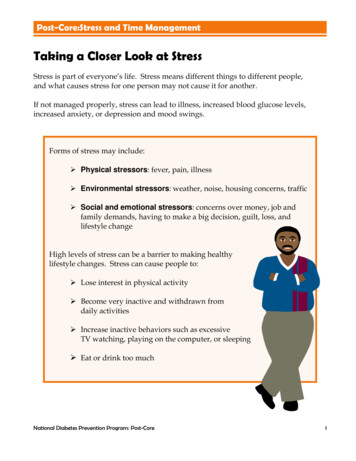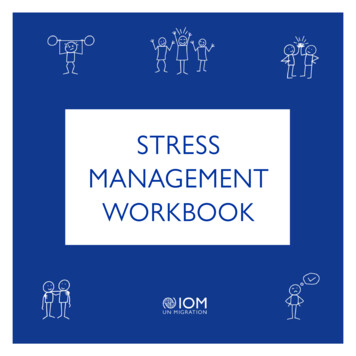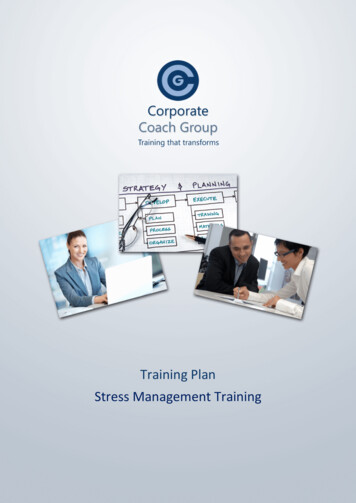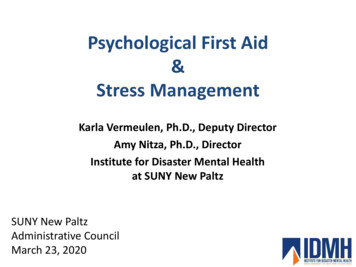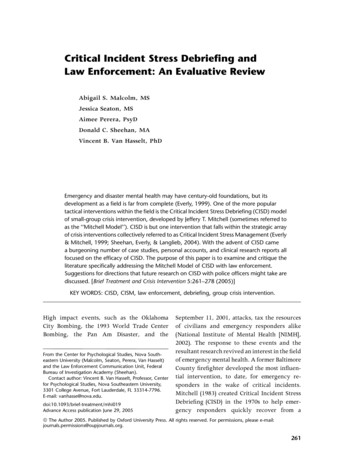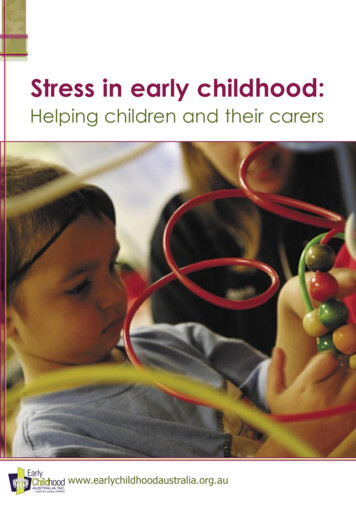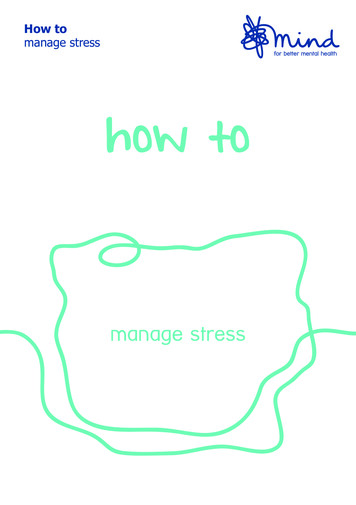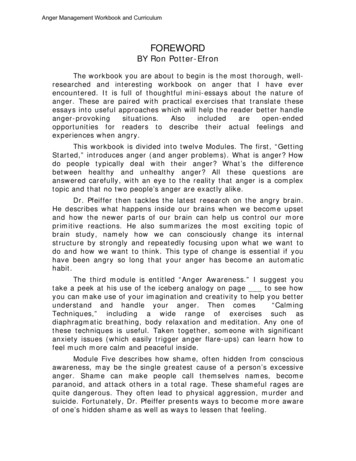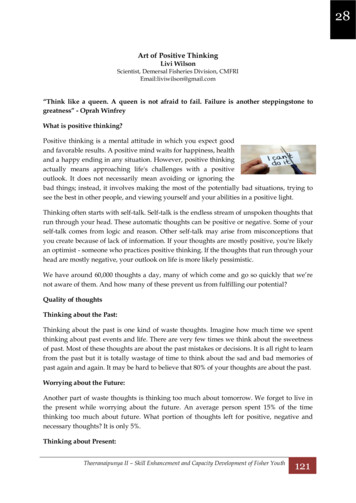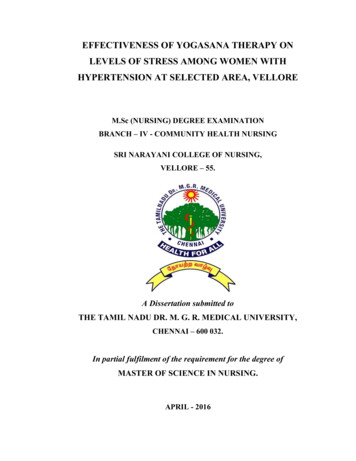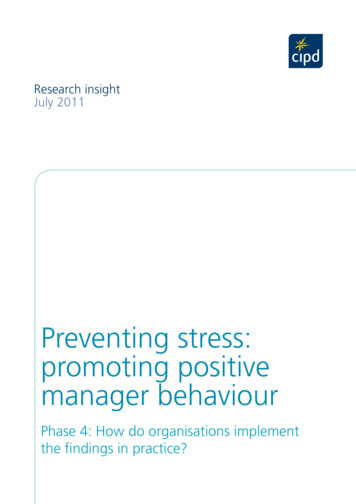
Transcription
Research insightJuly 2011Preventing stress:promoting positivemanager behaviourPhase 4: How do organisations implementthe findings in practice?
AcknowledgementsThis report was written by Emma Donaldson-FeilderThanks go to the research project steering group forand Rachel Lewis of Affinity Health at Work (Racheltheir continued support and guidance throughout theLewis is also a senior lecturer in occupationalproject: Ben Willmott of the CIPD, Rob Hargreavespsychology at Kingston Business School). Emmaformerly at IIP and Peter Kelly, Tony Almond andand Rachel (together with Jo Yarker) have beenClare McNicholas from the HSE. Thank you also toconducting the ‘Preventing stress: promoting positiveall the organisations that participated in and helpedmanager behaviour’ research programme since 2005.co-fund this research study through membership ofAffinity Health at Work is a specialist consultancythe research consortium. They all gave generously ofoffering research, consultancy and training to improvetheir time during the course of the research and weworkplace health and well-being.are most grateful.For further details about the research project orAffinity Health at Work’s research is largely fundedAffinity Health at Work, please contact Rachel Lewis,through the contributions of our research consortium.rachel@affinityhealthatwork.com or EmmaWe are always open to new organisations joining theDonaldson-Feilder, emma@affinityhealthatwork.comconsortium and offer a range of benefits to members,including quarterly meetings on relevant topics andprivileged access to the tools and guidance emergingfrom our research. If you are interested in becominga research consortium member, please contact EmmaDonaldson-Feilder: emma@affinityhealthatwork.com
ContentsBackground and introduction2Research aims and methodology61 Summary of cases72 Organisational case studies103 Exploration of incomplete interventions264 Overall learning and advice to organisations28Final conclusions31Further resources and sources of information32Preventing stress: promoting positive manager behaviour1
Background and introductionResearch suggests that line managers play a pivotalto fill this gap. The ‘Preventing stress: promotingrole in workplace stress management. This meanspositive manager behaviour’ research programme hasthat, for employers to reduce and manage workplaceconsisted of four phases, of which the current study isstress effectively, they need to ensure that managersthe fourth.demonstrate the skills and behaviours that allowthem to manage their staff in ways that minimiseThe first three phases of the research programmework-related stress. Until recently there was very littleThe following information has been summarisedresearch evidence to clarify which manager behavioursfrom the report on phase 3 of the research (see CIPDare relevant in this context. Funded by the Health and2009). The flow diagram in Figure 1 summarises theSafety Executive (HSE), Chartered Institute of Personnelfirst three phases of the ‘Preventing stress: promotingand Development (CIPD) and Investors in People (IIP),positive manager behaviour’ research programme.PHASE 1we have applied a behavioural competency approachData collected in phase 1 resulted in the emergent ‘Management competencies for preventing andreducing stress at work’ framework, consisting of 19 competencies.Participants: 216 employees, 166 line managers and 54 HR professionals. PHASE 2Data collected in phase 2 resulted in: a refined version of the ‘Management competencies forpreventing and reducing stress at work’ framework, consisting of 4 competencies and 12 subcompetencies; and a 66-item ‘Stress management competency indicator tool’ to measure the relevantcompetencies.Participants: 313 participants to initially test the tool. 22 organisations, 152 managers and 656 directreports then used the tool as an upward feedback measure.PHASE 3 2In phase 3, an intervention was designed to develop managers’ management competencies forpreventing and reducing stress at work. Data collected in phase 3 provided both qualitative andquantitative evidence for the efficacy of this intervention approach.Participants: 207 managers and 594 employees participated in the intervention study.Preventing stress: promoting positive manager behaviour
The refined version of the ‘Management competencies(MCPARS) that emerged from the first two phases offor preventing and reducing stress at work’ frameworkthe research is shown in Table 1.Table 1: The ‘Management competencies for preventing and reducing stress at work’ frameworkCompetencySub-competencyRespectful and Integrityresponsible:Managingemotions andhaving integrityExamples of manager behaviourIs a good role modelSays one thing, then does something differentTreats me with respectIs honestSpeaks about team members behind their backsManagingemotionsIs unpredictable in moodActs calmly in pressured situationsPasses on his/her stress to meIs consistent in his/her approach to managingTakes suggestions for improvement as a personal criticismPanics about deadlinesConsiderateapproachMakes short-term demands rather than allowing me to plan my workCreates unrealistic deadlines for delivery of workSeems to give more negative than positive feedbackRelies on other people to deal with problemsImposes ‘my way is the only way’Shows a lack of consideration for my work–life balanceManaging and Proactive workcommunicating managementexisting andfuture workCommunicates my job objectives to me clearlyDevelops action plansMonitors my workload on an ongoing basisEncourages me to review how I organise my workWhen necessary, will stop additional work being passed on to meWorks proactivelySees projects/tasks through to deliveryReviews processes to see if work can be improvedPrioritises future workloadsProblem-solvingIs indecisive at decision-makingDeals rationally with problemsFollows up problems on my behalfDeals with problems as soon as they ariseParticipative/empoweringGives me the right level of job responsibilityCorrectly judges when to consult employees and when to make a decisionKeeps me informed of what is happening in the organisationActs as a mentor to meDelegates work equally across the teamHelps me to develop in my roleEncourages participation from the whole teamProvides regular team meetingsGives me too little directioncontinued overleafPreventing stress: promoting positive manager behaviour3
Table 1 continued: The ‘Management competencies for preventing and reducing stress at work’ frameworkCompetencySub-competencyExamples of manager ging conflictActs as a mediator in conflict situationsActs to keep the peace rather than resolve conflict issuesDeals with squabbles before they turn into argumentsDeals objectively with employee conflictsDeals with employee conflicts head onUse oforganisationalresourcesSeeks advice from other managers when necessaryTakingresponsibility forresolving issuesFollows up conflicts after resolutionUses HR as a resource to help deal with problemsSeeks help from occupational health when necessarySupports employees through incidents of abuseDoesn’t address bullyingMakes it clear he/she will take ultimate responsibility if things go wrongManagingthe individualwithin theteamPersonallyaccessiblePrefers to speak to me personally than use emailProvides regular opportunities to speak one to oneReturns my calls/emails promptlyIs available to talk to when neededSociableBrings in treatsSocialises with the teamIs willing to have a laugh at workEmpatheticengagementEncourages my input in discussionsListens to me when I ask for helpMakes an effort to find out what motivates me at workTries to see things from my point of viewTakes an interest in my life outside workRegularly asks ‘how are you?’Treats me with equal importance to the rest of the teamAssumes, rather than checks, I am okay Crown CopyrightThe ‘Preventing stress: promoting positive Upward feedback report: Manager participantsmanager behaviour’ interventionand their direct reports completed the ‘StressAs shown in Figure 1, phase 3 of the researchmanagement competency indicator tool’, theprogramme was an intervention study. It involvedquestionnaire that was produced in phase 2 of thedesigning and evaluating an intervention aimed atresearch. Direct reports were asked to rate theirhelping managers show the relevant competencies/manager’s behaviour, whereas managers werebehaviours. The intervention was based on theasked to rate their own behaviour. Provided at leastframework of MCPARS that had been developed inthree direct reports responded to the questionnaire,the first two phases of the research (as shown in Tablea feedback report was generated, showing the1). It was made up of two elements:manager how their behaviour was perceivedin terms of the four competencies and 12 subcompetencies. The feedback report also allowedmanagers to see how their self-score comparedwith the average of their direct reports’ score4Preventing stress: promoting positive manager behaviour
for each of the individual behaviours/questions.case studies to show how this process has worked inFeedback was generated at two different timeother organisations would be a useful adjunct to thepoints: initially prior to attending the workshop;guidance already produced from the research. Thereand then at a follow-up point three months afterwas also interest in the potential facilitators of andthe workshop.barriers to introducing interventions based on the Half-day workshop: Manager participantsresearch, together with ways of overcoming barriers.attended a workshop that aimed to help them:explore the importance of positive managerWhile phase 3 of the research provided valuablebehaviour; increase awareness of their owninformation about the learning and developmentbehaviour; and equip them with the tools to furtherintervention and its implementation in participatingenhance and/or develop their skills. This workshoporganisations during the research study, it couldwas provided face to face to groups of up tonot capture what happened following the TTT12 managers. It combined structured individualand how organisations implement the researchexploration of the manager’s feedback report withfindings in-house or the facilitators and barriers theydeveloping an understanding of the behavioursencounter. In order to support the wider population ofincluded in the ‘management competencies fororganisations and professionals that are interested inpreventing and reducing stress at work’ framework.using the research findings, we identified that it wouldThe workshop design was highly interactive,be beneficial to generate longitudinal case studies,including individual reflection, small groupincluding capturing information about facilitators anddiscussion, case studies, vignettes, plenary debatebarriers. The current research was therefore a follow-and analysis, and other exercises to help managersup qualitative study to generate longitudinal caseunderstand which behaviours they needed tostudies about the integration of the research findingsdevelop and how they might do so.in practice in the different organisations.Groups of managers from 16 organisationsparticipated in this intervention. Findings showed thatthe intervention led to significant behaviour change,particularly for managers who had not been showingthe behaviours identified as important for preventingand reducing stress in their team before theintervention. The findings of phase 3 were publishedin June 2009 and can be found at cipd.co.uk/subjects/health/stress/ preventing stressAt the end of phase 3, participating organisationswere invited to send a representative to a train thetrainer (TTT) session to learn how to use the materialsdeveloped during the research. The aim was to enablethe organisations to run the learning and developmentintervention in-house from then on.The need for further researchOne of the findings from a usability study conductedas part of phase 2 of the research was thatorganisations, and HR/OH/H&S professionals inparticular, were keen to have further support materialsto help them integrate the research findings into theirown practices. In particular, it was suggested thatPreventing stress: promoting positive manager behaviour5
Research aims and methodologyThe purpose of this study was to capture the learningIn total, ten organisations took part in the study. Thesefrom organisations as they integrated the researchwere:findings, including the learning and developmentintervention, into their practices and procedures. Avon and Somerset Probation ServiceWithin this, the specific aims were as follows: British Geological Survey UK transportation business to conduct a structured follow-up of a sample Oxford City Councilof organisations and the way they take the Northern Health Board‘Management competencies for preventing and Northumbria Healthcare NHS Foundation Trustreducing stress at work’ (MCPARS) findings forward Royal Free Trust to capture the different approaches taken by a telecommunications businessdifferent organisations and the learnings these Western Health Boardgenerate UK probation trust. to generate longitudinal case studies basedon organisations’ experiences of integratingSection 1 provides a summary of the ten cases.the MCPARS findings into their practices andSections 2 and 3 provide more detail on, firstly, theprocedures.cases where interventions took place and, secondly,the cases where interventions were still incompleteA qualitative longitudinal design was used,or stalled by the end of the case study period.involving interviews with a relevant individualSection 4 provides a review of overall learning andfrom each organisation over the period of a year.advice for organisations.These individuals were interviewed at four timepoints: October 2009, February 2010, May 2010and September 2010. The individuals who wereinterviewed will be referred to as the ‘champion’throughout the case studies.Semi-structured interview pro formas were designedto cover: the context within the organisation, including stressmanagement activities, management/leadershipdevelopment and use of a competency framework how and where the MCPARS intervention had beenrolled out how the intervention and other elements ofMCPARS research findings had been integrated intothe organisation’s practices and procedures facilitators to roll-out/integration barriers to roll-out/integration and how they hadbeen overcome.6Preventing stress: promoting positive manager behaviour
1 Summary of case studiesTable 2: Summary of the cases studies included in phase 4 researchOrganisationWho was responsiblePlanned interventionWhere it fittedWhat has been implementedso farAvon and Somerset ProbationServiceHealth and Safety M andatory intervention (360-degreefeedback and training programme) forall managers.Within managementdevelopment although run byHealth and Safety T he first questionnaires havebeen issued to managers andinterventions were due to run inNovember 2010.Within HR, focused aroundmanagement development A s part of ‘The Deal’ discussionswith managers. E mbedding MCPARS into generalcompetency frameworkBritish Geological Survey:HR N atural Environment ResearchCouncil 780 employeesNorthern Health BoardStress Prevention Managerfrom the Occupational HealthService, part of HR E mbedding MCPARS through followon from HSE Management StandardsSurvey, and as part of a widermanagement development initiative. P lanning to lead to full 360-degreefeedback and intervention A s part of discussions withsenior management to focusattention on their managementbehaviour. E mbedding into existing competencyframeworks. E mbedding into seniormanagement competencies Using the findings as guidance I ntegration into ILM managementdevelopment U se of MCPARS questionnaire to followup stress risk assessment I ntegration into other managementtraining and/or provision of stand-aloneMCPARS course7Preventing stress: promoting positive manager behaviourPart of a stress preventionprogramme, but with links tomanagement development Using the findings as guidance I ntegration into ILMmanagement development N ot clear whether other plannedactivities happened or not
Table 2: Summary of the cases included in phase 4 research continuedOrganisationWho was responsiblePlanned interventionWhere it fittedNorthumbria Healthcare NHSFoundation Trust:Consultant ClinicalPsychologist in OccupationalHealth, which sits within HRand OD. (Health and Safetysits in a different directorate.) S tand-alone intervention of 360-degreefeedback and workshops for groups ofmanagers using the questionnaire andexercises developed in the researchProvided by the Consultant Two cohorts of managers haveClinical Psychologist inbeen through the feedback plusOccupational Health under theworkshop interventionstress management/well-being Follow-up session for first cohortbannerabout to take place NHS foundation trust 6,000 employees A cute trust and communityhospitals, including 3 districtgeneral hospitals plus a numberof community hospitals I ntegration into other activities – healthand well-being strategy, leadershipdevelopment, change managementWhat has been implementedso far I ntegration into health and wellbeing strategy has happenedand other integration planned B iggest geographical region inthe UKOxford City Council: Local authority 1,200 employeesHealth and Safety Manager,who sits within HR, plus asenior manager from one ofthe operational directorates 5,200 employees 360-degree feedback for managers Mention in managing safely course O verall: 3 city centre offices,2 depots and various satellitepremisesRoyal Free NHS Trust: S tand-alone workshop or integration inmanagement developmentHealth and Work CentrePsychological Services W ithin Psychological Services as part of Within ODcoaching and one-to-one discussionswith employees and managers Within management training8Preventing stress: promoting positive manager behaviourAim was to position MCPARSwithin managementdevelopment, thoughresponsibility lay with Healthand Safety M entioned in managing safelycourse Used in coaching interventions R ecommended in a white paperset to form ongoing strategyfor OD
Table 2: Summary of the cases included in phase 4 research continuedOrganisationWho was responsiblePlanned interventionWhere it fittedWhat has been implementedso farTelecommunications businessGroup Health Adviser fromwithin the Health, Safety andWell-being function, which ispart of HR U sing guidance based on MCPARS tofollow up stress risk assessmentsWithin Health and Wellbeing, but linking across tomanagement developmentand change management G uidance based on MCPARS hasbeen used to follow up stressrisk assessments E ncouraging managers to complete theself-report MCPARS questionnaire I ntegrating MCPARS into the new onestop-shop management developmentportal M anagers have beenencouraged to completethe self-report MCPARSquestionnaire I ntegrating MCPARS into thenew management developmentportal and change managementframework is under way I ntegrating MCPARS into changemanagement frameworkUK probation trustHealth and Safety T rialling as a stand-alone intervention in4 areas of the serviceNo organisational ‘fit’established No implementation as yetUK transportation businessHR A s part of a suite of training anddevelopment around health and wellbeingWithin health and well-being No implementation achievedWestern Health BoardEmployee Well-being, whichsits within the OD function ofthe HR department (Healthand Safety sits in a differentdirectorate) G uidance provided through the wellbeing intranet siteWithin Employee Well-beingand linked to managementdevelopmentIntegration into all appropriateemployee well-being activities,including: S elf-report questionnaire offered toparticipants in manager networks U se within the new managers trainingprogramme website guidance well-being policy g uidance within relevantinitiatives f acilitated networks andconsultation promotion at events9Preventing stress: promoting positive manager behaviour
2 Organisational case studiesCase study: Avon and Somerset Probation ServiceStress management, management development and competency frameworkStress management/health and well-being activitiesInitially Avon and Somerset Probation Service actioned a form of the HSE Management Standardsprocedure for stress risk assessments. This had been running for the past three years as an individualsystem. Each individual would complete an individual indicator tool (which was altered to be applicableto individuals) that would then be presented to their line manager. The line manager would then,in a meeting, agree actions from that. If the individual was unable or unwilling to talk to the linemanager directly, they were able to use an advocate or go to a more senior manager. All the individualreports were then compiled into an organisational stress risk assessment to identify trends or hotspots.Eighty per cent of employees completed these forms on a yearly basis. It was felt that the initiativehad drastically impacted upon stress-related absence, the estimates being that without the initiative,absenteeism would be two or three times higher. However, it was perceived badly by employees andseen as too much work. The perception did improve with a re-promotion highlighting that this wasan initiative focused on making their working lives easier, as opposed to the common initiatives abouttargets and offender management. Over the summer, this was restructured to be an organisationalinitiative as a result of the staff issues. The policy and procedures of the service were also changed to bemore consistent with the HSE recommendations.There is health and safety training for all managers. This takes the form of a monthly briefing focusedon one particular topic that is sent out to all managers. To reinforce this message, there are also oneto-one briefings with managers that focus upon health and safety. In 2011, Health and Safety Level 2training will also be actioned for all managers.Within the year, Avon and Somerset put in place a consultancy service with a group of counsellors. Staffthat work on high-risk cases are automatically booked an appointment to see a counsellor regardlessof whether they have requested the appointment or not. In addition, anyone that would like to see acounsellor and is not working on such a case can do. These appointments are arranged both on a oneto-one and a group basis. Staff are given time off for these appointments and anecdotal feedback hasbeen very positive about the initiative.Leadership/management developmentThere are a series of probation-specific management workshops offered to all probation officermanagers, along with an NVQ in management. There was a feeling that, although all managers havebriefings on stress management, it was not a focus in management development; and in fact managersdid not receive any development around people management.After identifying some funds over the summer, an initiative was launched whereby all managers wereprovided with 50 to do something related to their personal health development, such as going to thegym or getting a health check. Although the initiative was advertised and launched, soon afterwardsit was realised that the funds were not available after all, and in fact the incentive was pulled and themoney not provided.10Preventing stress: promoting positive manager behaviour
Case study: Avon and Somerset Probation Service continuedCompetency frameworkA general management framework did exist but across the whole of the project time period, therewas a new framework in development that would include people management and specifically thestress management competencies work. Unfortunately, despite plans, at the time of writing the revisedframework had not been finalised or launched.Using the MCPARS findingsStand-alone MCPARS interventionAvon and Somerset have decided to launch the MCPARS intervention (including 360-degree feedback)as a compulsory training intervention for all managers and therefore a core training requirement. Theresults of the intervention will be seen as both developmental and performance-related. If managersreceive poor results from their direct reports at first, they will be invited to attend the training andmonitor if there has been an improvement three months later. If after three months there is a declinein performance, managers will be offered to repeat the training or engage in a one-to-one coachingsession in order to focus their development and understanding of their development areas. If aftera further three months the manager has still not improved, or has declined further, the process willbecome one of performance management and the manager could face dismissal.Although this is a controversial approach, Avon and Somerset feel that it is too big a risk for their serviceto have managers who are not managing effectively and who may be causing stress in others. It is feltthat to ignore a manager who has been found to be poorly managing, and who does not improve,would be putting the service open to litigation cases from employees – tantamount to ignoring resultsof a risk assessment.Although this was planned to be launched in March 2010, a government-led organisational restructure(moving from a board to a trust) took place in the spring. This involved 80% of teams having linemanagement changes. It was decided that it would be best that the teams were embedded beforeembarking on the initiative. The first 360 questionnaires were distributed in October, and the first coursedue to run in November.Integration into other activitiesAs described above, it is planned that the MCPARS work will be embedded within their generalcompetency framework in the coming months.What has helped in integrating the MCPARS intervention/related activities? Senior management sign-off: Although it wasn’t necessarily felt that senior management werefully bought in to the intervention, their sanctioning of it meant that roll-out could progress. Making the intervention mandatory: This is felt to be key in ensuring that the intervention istaken seriously and recognised as important within the service. Labelling the intervention ‘management development’: It is now felt that there is not a realproblem with stress in the organisation, and therefore slotting the intervention into managementdevelopment has ensured it is received better. Interest from managers: Managers within this probation service were very keen for developmentopportunities and training, and therefore welcomed the opportunity. Dealing with the data in-house: Avon and Somerset have designed their own system and will runthe initiative in-house without the need for an external provider. It is very much felt that if an externalprovider had been involved, the intervention would have been cut due to spending restrictions.Preventing stress: promoting positive manager behaviour11
Case study: Avon and Somerset Probation Service continuedWhat has been a barrier in integrating the MCPARS intervention/related activities? Reduced stress absenteeism figures: Across the year, absenteeism figures have dropped to fourdays per year per employee in Avon and Somerset Probation Service. Despite a suspicion from thechampion that this is not due to an actual improvement, but actually a result of presenteeism, thesenior management have become less concerned about managing stress. Union involvement: Since the election of the new government, it is perceived that unions havebeen a significant barrier by resisting any organisational initiative and creating a negative atmosphere.Case study: British Geological SurveyStress management, management development and competency frameworkStress management/health and well-being activitiesDuring year BGS have undertaken the Management Standards survey across the whole organisation.It ran in January/February and received a 72% response rate, which was very positive for BGS. This willbe repeated every 18 months. The survey was well received, with a good senior management response.The results were presented both to the board and to all staff face to face. Staff were also asked for theirsupport on some of the issues raised.BGS are committed to demonstrating that they will take action from the responses. The key issues thatemerged were around change, role and senior management communication, with employees not valuingappraisals. Training is now being undertaken around appraisals to improve the process; and a changemanagement team has been formed to look at change going forward. Senior management are alsoworking to make themselves more visible by having regular open sessions with staff.Stress awareness sessions have been held with team leaders and senior managers, using the HSE criteriabut particularly focusing on the amount of change within the organisation.BGS are in the process of building a health and well-being part to their intranet. Although BGS offersmany opportunities such as gym, social events and flexible working, it is not perceived that staff appreciateor use these as much as they could. The intranet will aim to increase awareness of health and well-beingactivities.Health and safety training is offered to all staff, with training content focused by job level and job type. Allstaff, when undertaking a new project, are required to undertake a risk assessment and get directed to anonline health and safety procedure.Leadership/management developmentManagement training is offered for all management levels; there is a series of management coursesdepending on the level of manager, and they are also planning an induction programme for newmanagers. There is also the Leadership for NERC (NERC, or the National Environment Research Council,is the govern
Preventing stress: promoting positive manager behaviour . 3. The refined version of the ‘Management competencies for preventing and reducing stress at work’ framework (MCPARS) that emerged from the first two phases of the research is shown in Table 1. Competency Sub-competency Examples o
